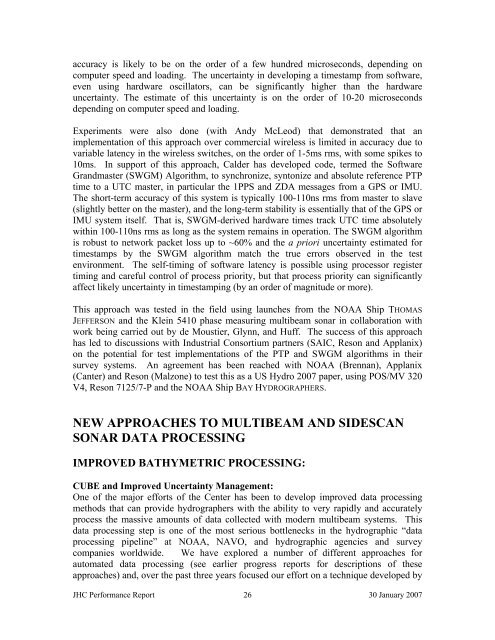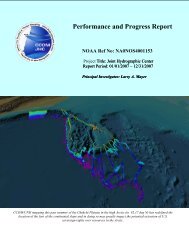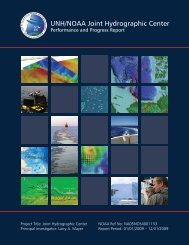Performance and Progress Report - John Doe FIX: put in the authors ...
Performance and Progress Report - John Doe FIX: put in the authors ...
Performance and Progress Report - John Doe FIX: put in the authors ...
You also want an ePaper? Increase the reach of your titles
YUMPU automatically turns print PDFs into web optimized ePapers that Google loves.
accuracy is likely to be on <strong>the</strong> order of a few hundred microseconds, depend<strong>in</strong>g on<br />
com<strong>put</strong>er speed <strong>and</strong> load<strong>in</strong>g. The uncerta<strong>in</strong>ty <strong>in</strong> develop<strong>in</strong>g a timestamp from software,<br />
even us<strong>in</strong>g hardware oscillators, can be significantly higher than <strong>the</strong> hardware<br />
uncerta<strong>in</strong>ty. The estimate of this uncerta<strong>in</strong>ty is on <strong>the</strong> order of 10-20 microseconds<br />
depend<strong>in</strong>g on com<strong>put</strong>er speed <strong>and</strong> load<strong>in</strong>g.<br />
Experiments were also done (with Andy McLeod) that demonstrated that an<br />
implementation of this approach over commercial wireless is limited <strong>in</strong> accuracy due to<br />
variable latency <strong>in</strong> <strong>the</strong> wireless switches, on <strong>the</strong> order of 1-5ms rms, with some spikes to<br />
10ms. In support of this approach, Calder has developed code, termed <strong>the</strong> Software<br />
Gr<strong>and</strong>master (SWGM) Algorithm, to synchronize, syntonize <strong>and</strong> absolute reference PTP<br />
time to a UTC master, <strong>in</strong> particular <strong>the</strong> 1PPS <strong>and</strong> ZDA messages from a GPS or IMU.<br />
The short-term accuracy of this system is typically 100-110ns rms from master to slave<br />
(slightly better on <strong>the</strong> master), <strong>and</strong> <strong>the</strong> long-term stability is essentially that of <strong>the</strong> GPS or<br />
IMU system itself. That is, SWGM-derived hardware times track UTC time absolutely<br />
with<strong>in</strong> 100-110ns rms as long as <strong>the</strong> system rema<strong>in</strong>s <strong>in</strong> operation. The SWGM algorithm<br />
is robust to network packet loss up to ~60% <strong>and</strong> <strong>the</strong> a priori uncerta<strong>in</strong>ty estimated for<br />
timestamps by <strong>the</strong> SWGM algorithm match <strong>the</strong> true errors observed <strong>in</strong> <strong>the</strong> test<br />
environment. The self-tim<strong>in</strong>g of software latency is possible us<strong>in</strong>g processor register<br />
tim<strong>in</strong>g <strong>and</strong> careful control of process priority, but that process priority can significantly<br />
affect likely uncerta<strong>in</strong>ty <strong>in</strong> timestamp<strong>in</strong>g (by an order of magnitude or more).<br />
This approach was tested <strong>in</strong> <strong>the</strong> field us<strong>in</strong>g launches from <strong>the</strong> NOAA Ship THOMAS<br />
JEFFERSON <strong>and</strong> <strong>the</strong> Kle<strong>in</strong> 5410 phase measur<strong>in</strong>g multibeam sonar <strong>in</strong> collaboration with<br />
work be<strong>in</strong>g carried out by de Moustier, Glynn, <strong>and</strong> Huff. The success of this approach<br />
has led to discussions with Industrial Consortium partners (SAIC, Reson <strong>and</strong> Applanix)<br />
on <strong>the</strong> potential for test implementations of <strong>the</strong> PTP <strong>and</strong> SWGM algorithms <strong>in</strong> <strong>the</strong>ir<br />
survey systems. An agreement has been reached with NOAA (Brennan), Applanix<br />
(Canter) <strong>and</strong> Reson (Malzone) to test this as a US Hydro 2007 paper, us<strong>in</strong>g POS/MV 320<br />
V4, Reson 7125/7-P <strong>and</strong> <strong>the</strong> NOAA Ship BAY HYDROGRAPHERS.<br />
NEW APPROACHES TO MULTIBEAM AND SIDESCAN<br />
SONAR DATA PROCESSING<br />
IMPROVED BATHYMETRIC PROCESSING:<br />
CUBE <strong>and</strong> Improved Uncerta<strong>in</strong>ty Management:<br />
One of <strong>the</strong> major efforts of <strong>the</strong> Center has been to develop improved data process<strong>in</strong>g<br />
methods that can provide hydrographers with <strong>the</strong> ability to very rapidly <strong>and</strong> accurately<br />
process <strong>the</strong> massive amounts of data collected with modern multibeam systems. This<br />
data process<strong>in</strong>g step is one of <strong>the</strong> most serious bottlenecks <strong>in</strong> <strong>the</strong> hydrographic “data<br />
process<strong>in</strong>g pipel<strong>in</strong>e” at NOAA, NAVO, <strong>and</strong> hydrographic agencies <strong>and</strong> survey<br />
companies worldwide. We have explored a number of different approaches for<br />
automated data process<strong>in</strong>g (see earlier progress reports for descriptions of <strong>the</strong>se<br />
approaches) <strong>and</strong>, over <strong>the</strong> past three years focused our effort on a technique developed by<br />
JHC <strong>Performance</strong> <strong>Report</strong> 26 30 January 2007




